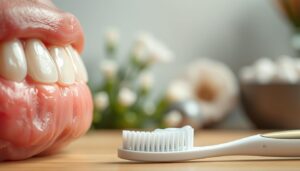Ever felt like your gums are trying to send you a message? Your gum health is a vital part of your overall well-being, yet it’s often overlooked. Neglecting your gums can lead to bigger problems than you might expect, like tooth loss or even systemic health issues
Good gum health is essential for maintaining a healthy mouth, but it’s easy to take it for granted. While we often focus on brushing and flossing our teeth, our gums need just as much attention. They play a crucial role in supporting our teeth, and when something goes wrong, it can have a ripple effect on our entire body. Whether it’s pain, bleeding, or a subtle change in appearance, your gums can communicate signs that should not be ignored. By recognizing the early warning signs, you can take action before it leads to more serious complications. In this article, we’ll explore the top 10 warning signs that your gums need immediate attention.
1. Persistent Bad Breath
Have you noticed that your breath isn’t as fresh as it used to be, no matter how often you brush? Chronic bad breath could be more than just a garlic-laden dinner; it might be a sign of gum disease. Bacteria buildup in your mouth can release foul-smelling gases, pointing to potential gum issues.
2. Red, Swollen Gums
Healthy gums should be a nice pale pink. If yours are red, inflamed, or feel tender to the touch, your body might be sounding the alarm. Swelling is often your immune system’s response to infection, and it could be the start of gingivitis.
3. Bleeding Gums
Do you see pink in the sink after brushing or flossing? Bleeding gums are one of the most common early signs of gum trouble. While occasional bleeding might not seem like a big deal, consistent bleeding could mean your gums are at risk of developing more serious issues.
4. Receding Gums
Do your teeth look longer than they used to? It’s not an optical illusion—receding gums expose the roots of your teeth, which can lead to sensitivity and further damage. Recession can stem from brushing too hard, gum disease, or even genetics.
5. Gum Pain or Discomfort
If your gums are aching or feel sore, don’t shrug it off. Pain is your body’s way of saying something isn’t right. Whether it’s from an abscess, irritation, or an underlying infection, it’s time to investigate.
6. Loose Teeth
Teeth shouldn’t wiggle unless you’re five years old and waiting for the tooth fairy. If your teeth feel loose, it might be due to bone loss or advanced gum disease. Left untreated, this can lead to permanent tooth loss.
7. Pus or Sores Between Gums and Teeth
This one’s a big red flag. Pus indicates infection, and sores can be a sign of an abscess or advanced periodontal disease. If you notice anything like this, don’t wait—see a dentist immediately.
8. Changes in Bite or Teeth Alignment
Have you noticed that your teeth aren’t meeting the way they used to? Gum disease can lead to bone loss, which changes the structure of your jaw and teeth. This isn’t just about aesthetics; it can make chewing and speaking more difficult.
9. Gums Pulling Away From Teeth
When gums start detaching from your teeth, it forms pockets where bacteria can thrive. These pockets deepen as gum disease progresses, making it harder to clean your teeth properly.
10. Increased Tooth Sensitivity
Does a sip of ice water or hot coffee send a sharp pain through your teeth? Sensitivity can happen when gums recede, exposing the tooth’s roots. This can be both painful and a precursor to more serious dental issues.
Prevention and Treatment
The best defense is a good offense, right? Daily brushing and flossing are your first line of defense against gum issues. Use a soft-bristled toothbrush and fluoride toothpaste, and don’t skip out on flossing—it’s your secret weapon for reaching those tight spaces.
Visiting your dentist regularly is just as important. Professional cleanings can remove tartar buildup that brushing alone can’t tackle. If you’re already experiencing signs of gum trouble, your dentist can guide you through treatments like scaling, root planing, or even surgery if needed.
Prevention and Treatment
Your gum health hinges on consistent care and proactive habits. Here’s how you can stay ahead of potential problems:
1. Daily Oral Hygiene
Brushing your teeth at least twice a day is essential, but the technique matters too. Use a soft-bristled toothbrush to avoid damaging your gums, and aim for gentle, circular motions that clean the gumline without abrasion. Pair this with fluoride toothpaste to strengthen your enamel and protect against decay.
Flossing daily is equally important. It removes plaque and food particles from between your teeth, areas a toothbrush simply can’t reach. For an extra boost, consider adding an antimicrobial mouthwash to your routine—it can help reduce bacteria and freshen your breath.
2. Diet and Hydration
A balanced diet can do wonders for your gums. Foods rich in vitamin C, like citrus fruits and bell peppers, strengthen connective tissues, while calcium-rich options like dairy products help maintain bone health. Staying hydrated is also key; water flushes away food debris and helps maintain saliva flow, which neutralizes acids and prevents bacterial growth.
3. Regular Dental Visits
Even with the best at-home care, plaque can harden into tartar, which only a professional cleaning can remove. Scheduling dental checkups every six months allows your dentist to spot early signs of gum disease and address them before they worsen.
4. Treatments for Gum Disease
If you’re already noticing signs of gum trouble, don’t delay seeking professional help. Your dentist may recommend treatments such as:
- Scaling and Root Planing: A deep-cleaning procedure that removes tartar from above and below the gumline and smooths the roots to help gums reattach.
- Antibiotic Therapy: Medications can be applied directly to infected gum pockets or prescribed to fight severe infections.
- Surgical Options: In advanced cases, treatments like flap surgery or bone grafts may be necessary to repair damage and restore gum health.
5. Lifestyle Changes
Certain habits can undermine your gum health. Smoking, for example, impairs your gums’ ability to heal and increases your risk of gum disease. Stress, too, can weaken your immune system, making it harder for your body to fight off infections. Quitting smoking and managing stress through exercise or relaxation techniques can support better gum health.
Taking these steps not only protects your gums but also boosts your overall health, keeping your smile bright and your body strong.
Your gums are essential for maintaining a healthy smile and overall wellness. Recognizing the warning signs early can make all the difference in preventing serious problems. Don’t wait until it’s too late—take charge of your gum health today!
By paying attention to the early warning signs—like redness, swelling, or bleeding—you can address potential problems before they escalate into serious complications. Remember, prevention is always easier and more cost-effective than treatment. Simple habits like consistent brushing, flossing, and regular dental visits go a long way in keeping your gums strong and your smile intact.
Your journey to healthier gums starts with awareness and action. Whether it’s adopting a better oral hygiene routine, adjusting your diet, or scheduling that overdue dentist appointment, every step you take makes a difference. Don’t wait for discomfort to force you into action—invest in your gum health today for a brighter, healthier future!




